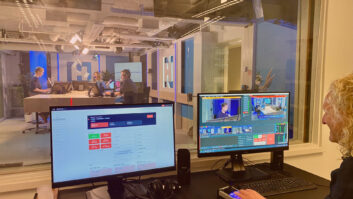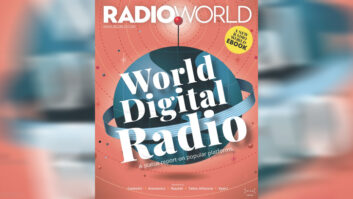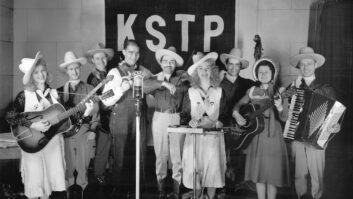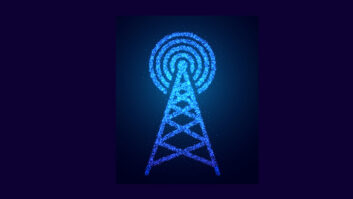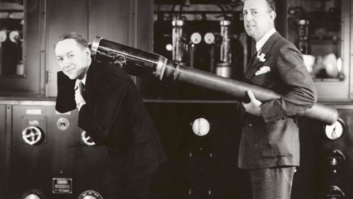“Visual radio” is more than a webcam streaming live footage of a radio station’s morning show. Properly executed, visual radio can be a compelling, multi-camera production that wows listeners and viewers and makes serious money both for its producers and the stations that stream visual radio content online.
Here are three examples of how broadcasters are putting this approach to work, as reported in the new Radio World eBook “Visual Radio.”

Four HD cameras feed a PC loaded with vMix switching software. Switching is automatic using a customized Arduino micro-controller that follows audio and is sourced from the show’s Wheatstone console.
PAYING VIDEO SUBSCRIBERS
Despite its name, the syndicated “Free Beer & Hot Wings Morning Show,” heard on Townsquare Media station WGRD(FM) in Grand Rapids, Mich., provides listeners with neither free ale nor chicken flaps. Hosts Gregg Daniels and Chris Michels chose the name after deciding it would attract more listeners than “The Gregg and Chris Show.”
But to fans who pay $5.95 a month (less with yearly or biyearly memberships), “FB&HW” does deliver HD-quality multi-camera video of the show in action, both live and on-demand. Many fans are willing to pay to see this content.
Down the hall in the same Townsquare Media production complex, WLHT(FM) morning show hosts Connie and Curtis also are captured on camera for viewers. However, because this footage is free, Townsquare Media shoots it using lower-resolution USB cameras and posts their antics to a dedicated channel on YouTube.
“Video is a pretty big deal for these programs,” said Market Engineering Manager Mike Maciejewski. “Both of them have thousands of followers, including paying viewers on the ‘Free Beer & Hot Wings’ site. Being able to see their favorite radio hosts in action really matters to our listeners, as the numbers clearly prove.”
The FB&HS morning show has higher-quality video production equipment due to the subscriber base, who are paying to see their broadcast heroes in action and expect quality akin to what they see on their home HDTVs.
To do the job, WGRD installed four fixed, zoomable Marshall 1080pHD-SDI TV cameras in the FB&HW studio, each of which covers a different view of the studio. These replaced a pair of consumer-quality webcams.
The feeds from all four HD cameras go into a PC loaded with vMix switching software. The switching between cameras is controlled automatically using an Arduino micro-controller customized by Maciejewski that follows the audio. It is sourced from the morning show’s Wheatstone LX-24 console.
��I wrote a program for the Arduino controller that allows it to cope with multiple audio sources intelligently,” said Maciejewski. “For instance, if the two hosts are talking all over each other, the Arduino will call up side-by-side camera views of them both. If everyone is laughing, the software will select a wide-angle group shot.”
The video production system for the Connie and Curtis morning show is similar, except that the video is shot using three web-quality fixed USB cameras.
“Again, we control the switching with an Arduino micro-controller production, but because there are fewer cameras we use a program call xSplit Broadcaster for the switching software,” Maciejewski said. “The feeds are also stored during the broadcasts, with clips selected afterwards to post on YouTube.”
Gearing up for visual radio production wasn’t without its challenges for TownSquare Media. “Not only did I have to learn how to produce and stream/record live multi-camera TV automatically, but we also had to modify the FB&HS studio to improve its sightlines, so that the cameras had unobstructed views,” said Maciejewski. “But the results have been well worth it, given how many people now watch both shows on video.”
At present, Townsquare Media has no plans to shoot video of its other radio shows in the Grand Rapids cluster. But at the corporate level, the company clearly is serious about creating video content; it recently hired Andy Meyer as vice president of original programming and head of video. He is former vice president of development/executive producer at Emmy-award winning Tremendous Entertainment and served as vice president of original programming for NBC Sports Network (formerly Versus) and Fuse Media.

CBS sports outlet 106.7 “The Fan” WJFK(FM) in Washington uses broadcast-quality HD cameras and a professional video switcher for “The Sports Junkies.” It is simulcast on Comcast SportsNet Mid-Atlantic as seen here; CSN controls the cameras remotely and adds graphics and b-roll. WJFK’s afternoon show stream is produced in-house.
SPORTS SIMULCAST
Sports outlet 106.7 “The Fan” WJFK (FM) in Washington uses five broadcast-quality HD cameras and a professional video switcher — in this case, a NewTek TriCaster — to] stream “The Sports Junkies” as visual radio online.
WJFK, owned and operated by CBS Radio, has gone one step further with visual radio. Since September 2016 the station has been simulcasting its video stream on cable television in the D.C., Maryland and Virginia region via Comcast SportsNet Mid-Atlantic (CSN), which now controls the cameras remotely and adds production elements.
Under the deal with CSN, “Sports Junkies” hosts John Auville, Eric Bickel, Jason Bishop and John-Paul Flaim are seen live weekday mornings and in replay weekday afternoons on CSN, CSNmidatlantic.com and the NBC Sports app. Video clips from the Sports Junkies are also being used on CSN’s TV, online, mobile and social media platforms including daily highlight episodes.
All of this comes from a WJFK radio studio that was rebuilt to look good on TV and mobile, as well as sound good on radio.
“Our CSN simulcast has grown our video reach not just in Washington, but in the mid-Atlantic region,” said Chris Kinard, program director for WJFK as well as a sister AM of the same call letters that goes by the moniker CBS Sports Radio 1580.
“It’s also raised the visibility of our overall brand and the morning show. And, with access to high-quality video clips, we have greatly increased our production of short clips of the show, which get a lot of traction on social media and our website.”
The TV simulcast of the Sports Junkies on CSN is in line with WJFK’s overall content strategy, which “is to make our content available on as many platforms as possible,” said Kinard.
“[Even] before the CSN simulcast, our morning show was streamed live and then re-aired in full until the afternoon show. Then the afternoon show was streamed live. We would [then] rotate the shows every evening and overnight.”
Today WJFK is as much a streaming visual radio station as it is a broadcast radio station. In addition to multi-camera coverage of its morning and afternoon drive shows, the station shoots and streams video from its DC Lottery Live performance space. This is where “celebrity guests and musical acts perform for live, intimate audiences, and we stream the performance on our website, TheFanDC.com,” Kinard said.
Generating multimedia content has changed WJFK’s approach to hiring. Rather than radio-only talent, “we look for a diverse set of multi-platform skills for all positions, including both on and off the air,” he said. “Job responsibilities and requirements are shifting as quickly as technology advances, and we look for people who are able to adapt to the changing needs and trends.”
The best part: Visual radio is making money for this CBS Radio sports station. “We have had success selling a presenting sponsor of the video streams that include on-air and on-screen recognition,” said Kinard. “We were also able to sell signage in our studio, and the visual element has allowed us to add value to food drops and product integrations.” The sign placements are designed to be swapped out easily, to change both show and advertiser identities on camera as needed.”
The cluster’s success in achieving cable TV simulcast of a morning show, plus making money from presenting sponsors and signage in its video streams, is a visual radio model that many radio broadcasters might wish to emulate. For such stations, Kinard recommends developing a visual radio model that is unique to their own content and formats rather than simply aping WJFK’s approach.
“I think every station is different and should tailor its goals and strategies to the strengths of the station and talent,” he said. “Some shows are more visually compelling than others. Some talent is suited for a live video stream, while others may be great at producing post-show videos. Or perhaps there are specific benchmarks or segments that would translate well to video.”
As for WJFK’s plans? Having taken the Sports Junkies to CSN, Kinard sees no reason why the station’s other visual radio broadcasts shouldn’t turn up on TV as well. “I think our shows all have the potential to be simulcast on TV.” Better yet, “there could also be OTT opportunities down the road, either on our own or with partners looking for compelling, original, exclusive, local content.”

Video Dads Travis Gilmour and Slavik Boyechko (rear, 7th and 9th from left) pose with students at WSKG in Binghamton, N.Y.
PAINLESS ENTRY
For many radio broadcasters, the concept of “visual radio” can be unsettling. If they’d intended to work in television production, they’d be in that medium.
But wait a minute: Visual radio doesn’t have to be the same as television, even though it works with images. That is because visual radio content can be grounded in the spoken word narrative style that is at the heart of radio story-telling, rather than the “visuals come first” approach of broadcast TV.
This is a lesson that Slavik Boyechko and Travis Gilmour have been teaching to public radio broadcasters across the United States. As partners in the Emmy-award winning production company Video Dads (because both shoot video and change their children’s diapers) and in Gear Dads (an equipment review website), these former PBS employees know how to “keep the radio” in online visual radio content. More importantly, they know how to teach these skills to nervous radio broadcasters who frankly might prefer to keep pictures out of their story-telling.
RADIO LEARNS TO BUILD ITS VIDEO PALETTE

The accompanying story is excerpted from the Radio World eBook “Visual Radio.” Video elements are no longer a novelty for a growing number of radio broadcast operations. These professionals use streaming and social media video tools to diversify their platforms and create new touch points with consumers. How are they doing it and what can we learn from their experiences?
Read it free at radioworld.com/ebooks.
“Radio is a narrative-driven medium,” said Gilmour. “The good news is that you can add visuals to this medium — specifically in terms of short form visual radio content aimed at YouTube and similar sites — without turning it into TV.”
To prove this point and calm nerves, Boyechko and Gilmour lead their radio students through three levels of visual radio production.
“In the first stage, the radio person produces a conventional radio story in audio, and then takes it to a easy-to-use video editing program, like Final Cut Pro 10, to add slides that relate to the narrative,” said Boyechko. “In the second stage, we ask them to shoot B-roll/cover footage (shots not of the person talking) to illustrate that narrative further, without moving away from the story-telling radio format. In the third phase, the radio person starts shooting their interviews on video; using them along with cover footage and stills to create a truly visual story.”
In the “visuals come first” world of conventional television, a lack of relevant footage can hamper what the story-teller can talk about. That’s a limit that radio producers don’t face, because the spoken word and natural sound can harness listeners’ imaginations to create pictures their minds.
So how can a radio producer transition to visual radio, without surrendering their narrative to available imagery and losing this advantage?
“The key is to use what you have,” said Boyechko. “It can be visually powerful just to show text of the words being spoken by the announcer, and bolster them with sound effects.”
Added Gilmour, “This means that you never have to compromise radio’s narrative approach when you go visual. You don’t have to conform to the norms of television production, even though you are producing audio-visual content for the web.”
